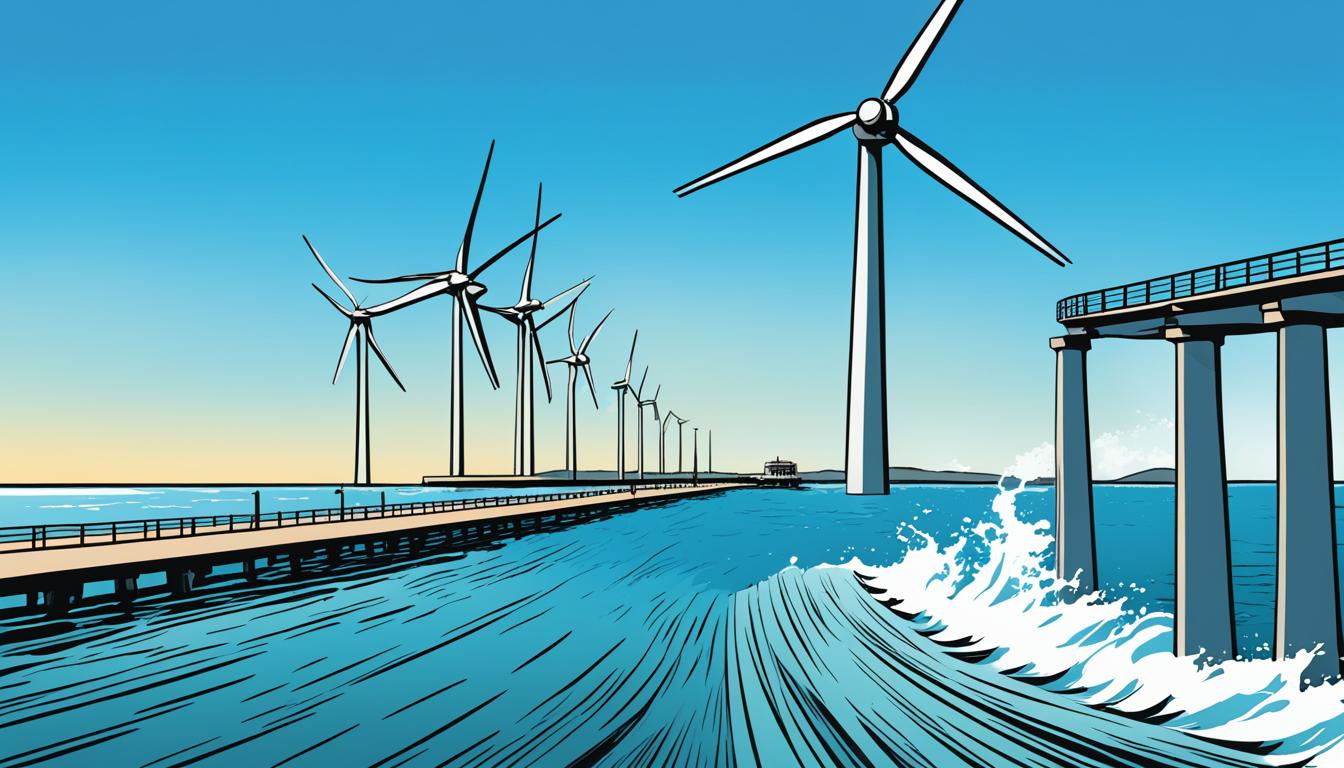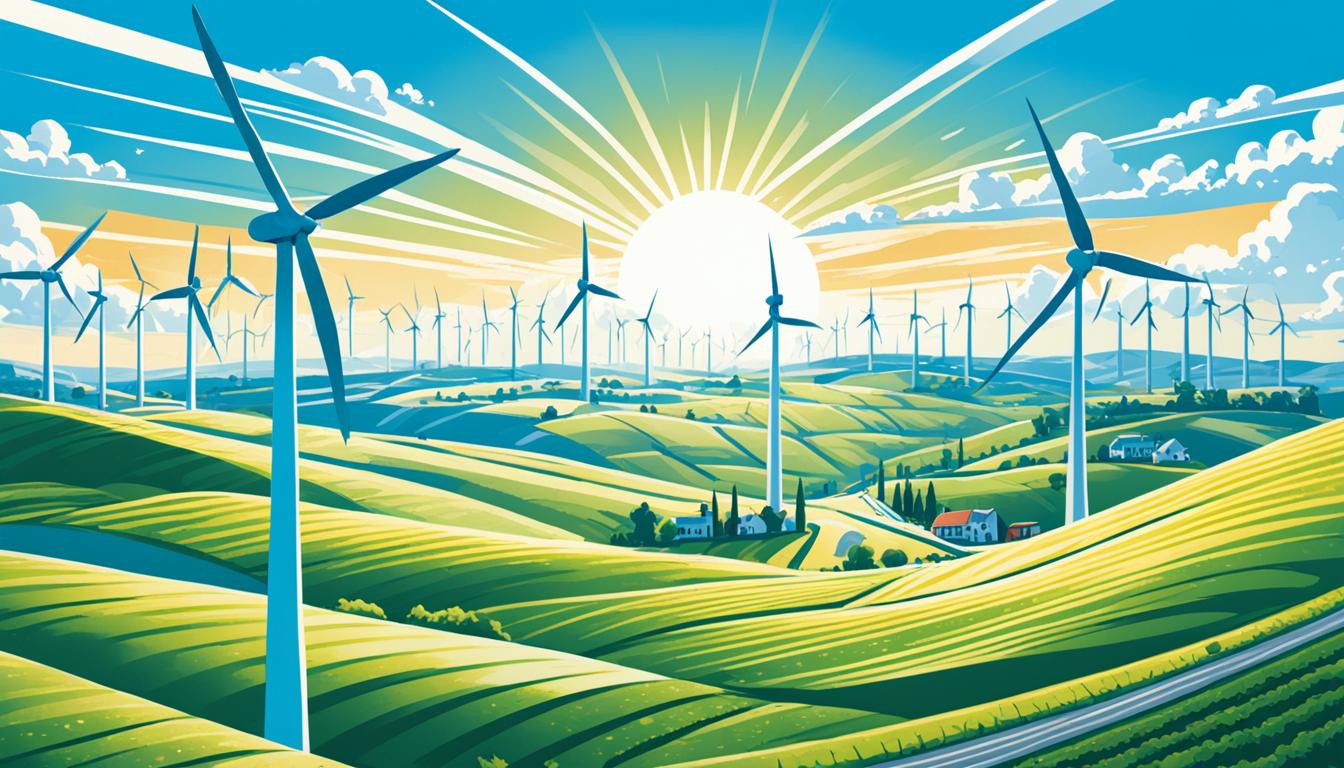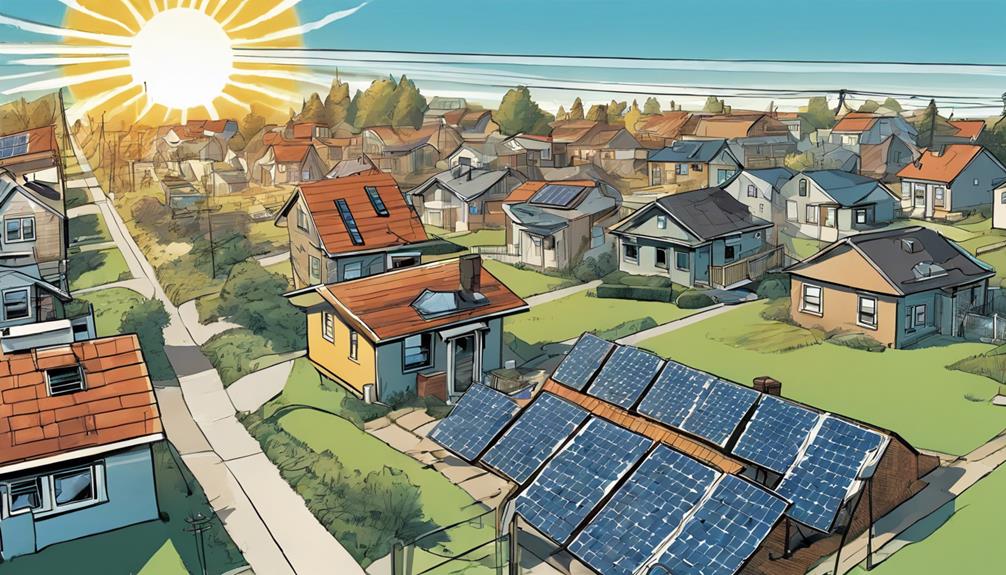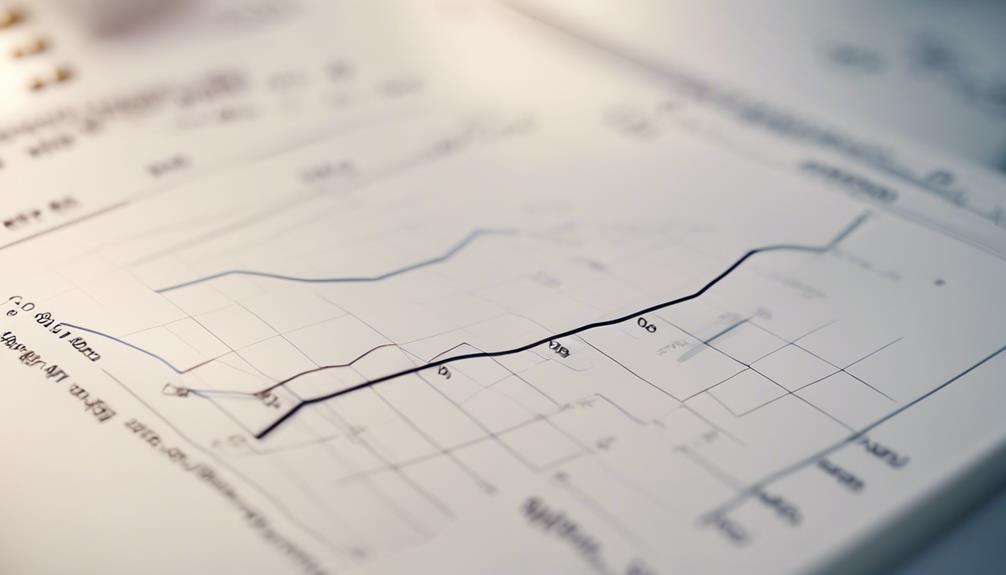Did you know that the ‘Pier Wind’ offshore wind project is set to start in 2027? It will be in the Port of Long Beach, covering 400 acres. The cost is estimated at $4.7 billion in today’s money1.
States across America are moving towards renewable energy. Engineers in Massachusetts are teaming up with British experts. They want to harness offshore wind power.
The sea near New Bedford, Massachusetts, is really windy. This makes it perfect for offshore wind farms. The UK is already making a big impact in this field. But in the US, it’s just getting started. Massachusetts and other states have big plans. They aim for 100% renewable energy in the next 25 years.
Key Takeaways:
- Offshore wind energy is booming in the UK, making up nearly 10% of their electricity2.
- The ‘Pier Wind’ project in Long Beach is expected to begin construction in 20271.
- New Bedford, Massachusetts, has great potential for offshore wind due to its windy coast.
- The US is seeking advice from the UK on offshore wind projects2.
- Plans are in place in Massachusetts for offshore wind to help achieve 100% renewable energy1.
The Potential of Offshore Wind Energy in the US.
The United States could greatly benefit from offshore wind energy, especially on the East Coast. The area has lots of offshore winds, making it perfect to create clean, renewable energy3. By using this energy source, the US can lessen its carbon footprint and work towards a sustainable future.
About two-thirds of the US’s offshore wind capacity is in waters too deep for traditional turbines4. But, thanks to new technology, we now have floating wind turbines. These can work in deep waters and access wind resources we couldn’t use before.
The Biden-Harris team wants to set up 30 gigawatts of offshore wind energy by 2030 in California5. This goal shows a strong push for more renewable energy and less greenhouse gas emissions. To reach this, we’ll need new ports and about $10 billion more in funding4.
California is working to have 25 gigawatts of offshore wind power by 20454. One big project at the Port of Long Beach could play a major role. This project, covering 400 acres with turbines as tall as the Eiffel Tower, could produce 20 megawatts of energy3.
Offshore wind energy could have a big impact. In California alone, the setup could power 1.5 million homes with 4.5 gigawatts of energy3. Yet, the US needs to overcome a $27.2 billion shortfall for wind energy projects along all coasts4. Investing in this could bring huge economic and environmental gains.
To sum up, offshore wind energy offers a big chance for the US, especially the East Coast. It can help the US use less fossil fuel, fight climate change, and create clean energy jobs. Overcoming the funding and infrastructure hurdles is key to making the most of this resource and moving towards a greener future.
The Role of British Expertise in US Offshore Wind Development.
The UK leads globally in offshore wind energy, using the sea breeze. British firms with experience in offshore wind farms are aiding US projects. This UK-US teamwork promises to boost offshore wind progress, bringing clean energy to both nations6.
British know-how can significantly help the US offshore wind sector grow. With nearly 10% of its electricity from offshore wind, the UK is ready to assist. Its firms offer technical skills, innovative tech, and managerial expertise for US ventures6.
Take New Bedford, Massachusetts, for instance. It’s the US’s most invaluable fishing port and could be an offshore wind nucleus6. The British consul in New England is keen on sharing UK know-how here. Their goal is to harness New Bedford’s outstanding wind resources, making it a leader in US wind energy7.
This partnership between British and US entities in offshore wind paves the way for economic and job growth. In the UK, the offshore wind sector employs about 8,000 people6. By collaborating, British companies can help create jobs and build a robust US offshore wind workforce. This move will boost the economy and reinforce the nation’s energy reliability and sustainability8.
Key Benefits of British Expertise in US Offshore Wind Development:
- Transferring technical knowledge and experience in offshore wind farm development and operation.
- Introducing innovative technologies and project management skills.
- Unlocking the potential of wind resources in areas like New Bedford, Massachusetts.
- Creating economic growth and job opportunities in the US.
Thanks to British collaboration, the US can hasten its offshore wind efforts, embracing this plentiful, clean energy. This partnership doesn’t just unite the UK and US but also helps both fight climate change and pursue renewable energy targets.
The Economic and Environmental Benefits of Offshore Wind.
Offshore wind farms bring both economic and environmental perks for a more sustainable future. By using wind turbines at sea, we not only boost the economy but also cut down on pollution. This shift towards clean energy helps make our planet healthier.
One big perk of offshore wind is the creation of new jobs. It’s like how British towns got a boost from these developments. The UK has already seen this benefit, with thousands of jobs in offshore wind. The US could see similar growth, creating more work in manufacturing, construction, and maintenance[9].
Offshore wind also has a positive effect on the environment. It’s crucial in fighting climate change and cutting down on fossil fuel use. These wind farms lessen coastal erosion and ocean acidification too. By generating clean energy, they reduce carbon emissions, helping us reach our clean energy targets[9][10].
Aside from these benefits, offshore wind helps diversify our electricity sources and upgrades the power grid. Wind at sea is often stronger than on land, meaning more energy can be generated. This is especially important for coastal and densely populated areas in the US. About half of the US population could get their power from offshore wind, helping the environment and communities[10].
Investing in offshore wind is great for both the environment and the economy. It moves us towards cleaner energy, creates jobs, and supports economic growth. By adopting offshore wind, we can fight climate change, improve air quality, and build a cleaner, better future for coming generations.
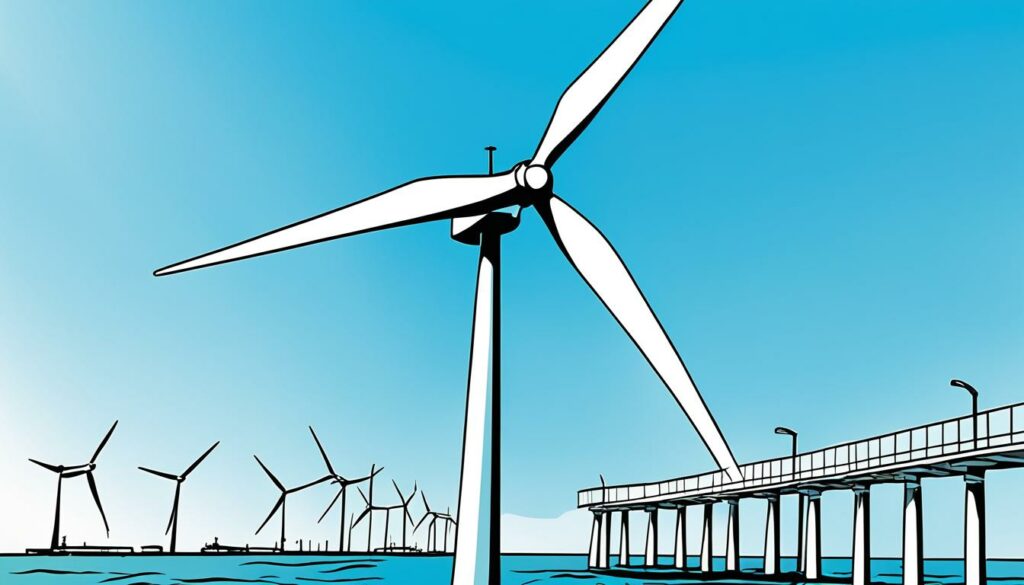
Challenges and Trade-offs in Offshore Wind Development.
Offshore wind development brings benefits but also faces challenges. The building and operating costs for offshore wind farms are high. This is due to the specialized equipment and large scale infrastructure needed. For example, the California Offshore Wind Project shows the need for collaboration at various governmental levels11.
Constructing these farms means installing thousands of turbines and extensive cables across the ocean12. Such massive projects require thoughtful planning and a lot of funding.
Another issue is the effect on marine life. Offshore wind farms could harm marine ecosystems. For instance, fish populations and fishing industries might suffer. The Vineyard Wind project could negatively impact commercial fisheries over a vast area of acres12.
It’s vital to consider the effects on marine biodiversity11. We need balanced decisions to support the sustainable coexistence of offshore wind farms and marine ecosystems.
There are steps being taken to tackle these issues. The National Audobon Society suggests using wind turbines carefully13. Studies have shown seabirds usually avoid wind farms near reefs and shallow waters13. Recommendations include a specific wind industry role in California and port upgrades for future growth while keeping environmental concerns in mind11.
This approach helps reduce the ecological impact of offshore wind farms. With the right measures and decision-making, the negative effects can be minimized.
Despite hurdles, offshore wind is gaining support as a clean energy alternative. U.S. Senator Ed Markey backs offshore wind to stimulate economic growth and reduce fossil fuel use. Favorable tax policies have been proposed12. The American Jobs Project also sees offshore wind as a way to create jobs in the advanced energy sector11.
By focusing on economic, environmental, and technological aspects, the offshore wind sector can address its challenges. It holds the promise of being a sustainable clean energy source.

Statistics on Offshore Wind Challenges and Trade-offs
| Challenge/Trade-off | Statistical Data |
|---|---|
| Cost of building and operating offshore wind farms | In the next decade, 3,411 turbines and 9,874 miles of cable are slated to be built across 2.4 million acres of federally managed ocean12. |
| Impact on marine life and fishing industries | The Vineyard Wind project, the first large-scale offshore wind farm approved for construction, could have negative economic impacts on commercial fisheries12. Tradeoffs need to be made regarding environmental concerns with offshore wind development and how it will impact competing uses of ocean resources11. |
| Efforts to address challenges and mitigate trade-offs | National Audubon Society endorses wind turbines with proper precautions13. Research suggests that seabirds tend to avoid offshore wind farms located near reefs and shallow areas, minimizing potential impacts13. Recommendations include appointing a California Offshore Wind Czar and upgrading ports to facilitate offshore wind development11. |
| Support and potential of offshore wind | U.S. Senator Ed Markey supports efforts to boost offshore wind for economic growth and fossil fuel reduction12. The American Jobs Project aims to create good-paying jobs in the advanced energy sector, including offshore wind11. |
State-Level Efforts and Legislation Supporting Offshore Wind.
In the U.S., various states are working hard to grow offshore wind energy. This is part of their efforts to push renewable energy and fight climate change. With supportive laws and benefits, these states are working towards a greener future.
Massachusetts is a leading state in supporting offshore wind. It aims to use 100% renewable energy by a set date. To reach this goal, it has passed laws and started programs to help the offshore wind industry grow. The state is working on the country’s biggest offshore wind farm, which is a big step towards its renewable energy goals.
Massachusetts is also working with British companies to create a wind power study program. This partnership lets them use the knowledge and skills of offshore wind leaders. This is not just about sharing knowledge. It also helps in making jobs and training people for those jobs.
State efforts and laws for offshore wind are key to moving to clean, renewable energy. Using offshore wind instead of fossil fuels helps states. It cuts down on pollution, creates new jobs, and leads to sustainability. These steps are important for our environment and economy.

Offshore Wind Projects in Connecticut and Maryland.
Connecticut and Maryland are making strides in offshore wind projects, enhancing clean energy and economic growth. They are increasing efforts in this area.
Connecticut
In Connecticut, offshore wind efforts are expanding. The redevelopment of the New London State Pier is notable, becoming a hub for offshore wind and boosting jobs14. It aims to use sea wind for clean energy15.
The Park City Wind project is significant, with a capacity of over 800 megawatts15. Led by Avangrid, it will power many homes and support Connecticut’s carbon-free goals by 204015.
The Revolution Wind project is also key, at around 300 megawatts15. It will help meet clean energy needs and cut carbon emissions15.
Maryland
Maryland is moving forward with offshore wind. It has four projects underway, advancing clean energy uses and economic growth14. These projects will help meet Maryland’s renewable energy targets.
With over $100 million in private funding, Maryland is boosting sustainable energy and jobs14. It’s focused on using wind to power homes cleanly, moving away from fossil fuels.
The Revolution Wind project, with 65 turbines, is a joint initiative between Ørsted and Eversource14. It will supply clean energy to Connecticut and Rhode Island, benefiting over 350,000 homes14. This shows how states can work together on renewable energy.
Another project, Sunrise Wind, will have more than 80 turbines and deliver 924 MW of clean energy to roughly 600,000 homes14. It’s expected to start by 2025, marking a renewable energy milestone for Maryland14.
Clearly, Connecticut and Maryland are dedicated to offshore wind projects for a sustainable future. Their actions support national clean energy and carbon reduction goals1514.
Technical and Infrastructure Considerations for Offshore Wind.
Offshore wind projects are complex and need lots of technical and infrastructure work. Experts must think about how to design and install strong wind turbines. They also plan how electricity gets from the ocean to our homes. It’s important to work together with engineers and people who care about the environment. This helps make offshore wind energy a success.
Building wind turbines for the ocean is a big challenge. These turbines must survive strong winds, salty water, and sea forces. We use new technologies and materials to make sure these turbines are safe and work well. This helps us get clean energy from the wind.
To use the wind power, we need a good way to bring it to land. We lay cables under the sea and build stations to connect with the power grid. This setup must be strong enough to handle lots of electricity. It ensures the power gets to us reliably.
Keeping offshore wind farms running well over time is key. They need regular checks and fixes to work their best. New maintenance methods help find and fix problems early. This keeps the wind farms producing energy without many breaks.
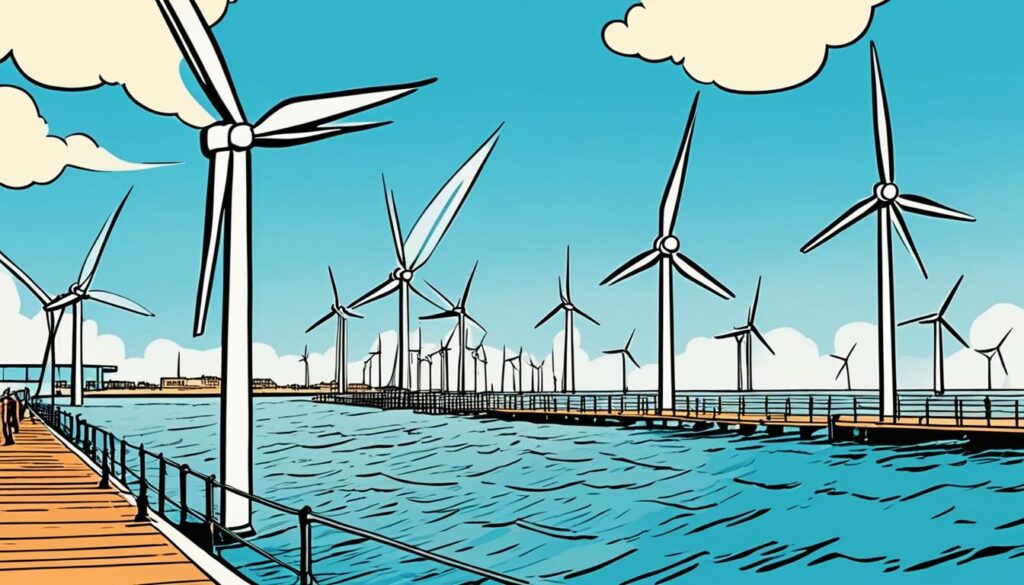
Offshore wind is great for making clean energy and cutting air pollution. Studies show New York and New Jersey will have eight new wind projects by 2030. These projects can power millions of homes and cut down seven million tons of CO2 a year. This change helps us use less dirty energy.
Offshore wind needs more than just the turbines in the sea. New York and New Jersey will need better power lines in many areas. This will make sure the extra wind power reaches our homes effectively.
Offshore wind can replace harmful energy sources, especially in areas that need it most. By putting turbines away from people, we avoid noise and sights some dislike. This means less trouble for communities while still getting the benefits of clean wind energy.
These wind projects help us switch to energy that’s better for the planet. They create good jobs in green and blue industries. This grows our economy and trains people with new skills. Companies worldwide, like Iberdrola, are working on these important projects. They show what’s possible in clean energy.
| Technical and Infrastructure Considerations for Offshore Wind | New York and New Jersey Offshore Wind Projects | South Africa Floating Offshore Wind Potential |
|---|---|---|
| Wind turbine design and installation | 8,100 MW of wind power by 203016 | 142.61 GW potential for floating wind power17 |
| Development of transmission systems | At least eight onshore transmission routes16 | 570 GW technical potential for floating offshore wind17 |
| Maintenance and operation protocols | – | – |
Public Perception and Community Engagement in Offshore Wind.
Understanding offshore wind farms is vital for everyone. We need to show people the good and the challenges of these projects18. Talking with local folks, fishermen, and others helps solve problems and build trust in wind energy19. Support from communities is key for these projects to work well and last long.
Where wind turbines are placed can change how people feel about them20. Studies show folks might not mind turbines if they blend well with the scenery. Offshore turbines are newer than land turbines and need special tech to handle the ocean air20. This makes them more expensive to set up.
It’s crucial to share clear info on how wind farms affect us and the area18. In Europe, places like the UK and Denmark have wind farms that actually help bring in tourists. A study showed wind farms don’t stop people from visiting an area. One wind farm even attracted 35,000 visitors in a summer18. Yet, we need more real data on how these farms impact tourism and leisure activities.
Working with communities lets developers know what’s important to them19. In the US, programs are studying how ocean energy projects can support local areas. These efforts make sure wind projects benefit everyone involved.
Offshore wind creates lots of power and jobs19. In Connecticut, a new wind project will supply a big part of the state’s electricity. And it’s not just about powering homes. These projects help our environment by using clean energy.
Making offshore wind work well takes effort and talking with people20. Offshore costs more for upkeep and connecting to power lines than onshore does. But the benefits like clean power and helping coastal towns are huge. Clear conversations are needed so everyone understands and supports these wind projects.
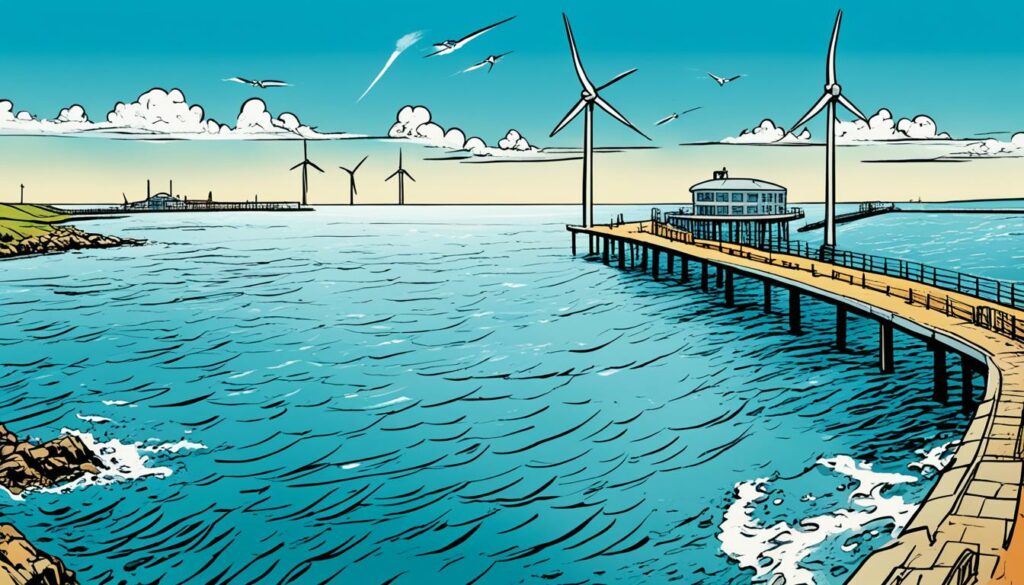
Conclusion
The US offshore wind industry is on the brink of powering a clean energy future. Working with British experts and engaging communities shows our dedication. This move towards green energy is not just vital but filled with economic and environmental rewards.
It offers jobs, reduces harmful emissions, and fights climate change. This industry stands as a beacon of hope for our planet’s future.
The Revolution Wind project near Rhode Island21 and the Pier Wind project in Long Beach22 showcase the industry’s vast capabilities. They show us how offshore wind can generate immense power and lower costs. These initiatives bring advanced technology and job opportunities, powering economic growth.
New Bedford and New London have become offshore wind’s forefront23. Investments here are not just about technology but also in people and the environment. This ensures marine life is protected while we advance.
By continuously investing in research and technology, offshore wind will soar. It’ll bring clean, economical energy to our country. This sector is key to lessening our dependence on oil and gas, marking significant strides against climate change.
This industry is a golden chance for a sustainable future. Embracing offshore wind energy means working together for a brighter, cleaner tomorrow.
We’ve reached the end of our offshore wind energy exploration. We trust you’ve gained insights into its potential to make our world greener and more sustainable.
